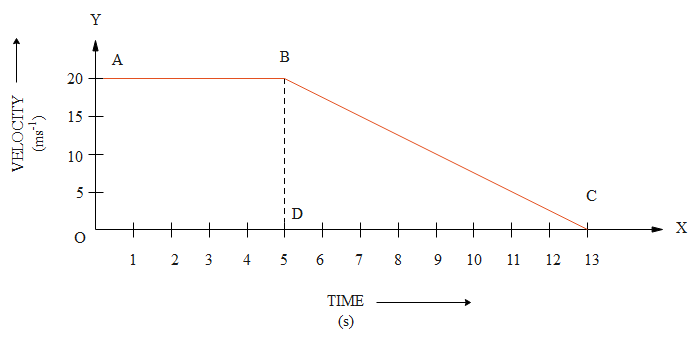
The velocity – time graph of a car moving on a straight road is shown: Calculate the acceleration of the car during the last 8 seconds:

(A) $ - 2.5m/{s^{ - 2}}$
(B) $ - 1.5m/{s^{ - 2}}$
(C) $0$
(D) Cannot be determined from the given plot
Answer
216.3k+ views
Hint: To answer this question we need to consider the acceleration of the car at every part of the graph. The graph is to be divided in sections as per the diagram and on the basis of the coordinates covered by the graph, we have to determine the acceleration. The time coordinate will help us to find the acceleration of the car specifically for the last 8 seconds.
Complete step by step answer:
We should know the formula of finding the acceleration.
The acceleration of the car will be given as the distance covered divided by the time taken.
From the graph we can determine that the acceleration of the car in the last 8 seconds will be given by the slope of the line BC.
To find the slope of BC we can write it as: $\dfrac{{BD}}{{CD}}$
From the graph we can put the values as:
$\dfrac{{(0 - 20)}}{{(13 - 5)}} = \dfrac{{ - 20}}{8} = - 2.5m{s^{ - 2}}$
So we can say that the acceleration of the car in the last 8 seconds is $ - 2.5m/{s^{ - 2}}$.
Hence Option A is correct.
Note: To avoid any difficulty while solving such type of questions we should be knowing that, we need to consider the part of the graph covered by the line of the object in the distance coordinate and time coordinate. The acceleration can be negative as well as positive depending on the slope of the line which depicts the movement of the object.
Complete step by step answer:
We should know the formula of finding the acceleration.
The acceleration of the car will be given as the distance covered divided by the time taken.
From the graph we can determine that the acceleration of the car in the last 8 seconds will be given by the slope of the line BC.
To find the slope of BC we can write it as: $\dfrac{{BD}}{{CD}}$
From the graph we can put the values as:
$\dfrac{{(0 - 20)}}{{(13 - 5)}} = \dfrac{{ - 20}}{8} = - 2.5m{s^{ - 2}}$
So we can say that the acceleration of the car in the last 8 seconds is $ - 2.5m/{s^{ - 2}}$.
Hence Option A is correct.
Note: To avoid any difficulty while solving such type of questions we should be knowing that, we need to consider the part of the graph covered by the line of the object in the distance coordinate and time coordinate. The acceleration can be negative as well as positive depending on the slope of the line which depicts the movement of the object.
Recently Updated Pages
JEE Atomic Structure and Chemical Bonding important Concepts and Tips

JEE Amino Acids and Peptides Important Concepts and Tips for Exam Preparation

Electricity and Magnetism Explained: Key Concepts & Applications

Chemical Properties of Hydrogen - Important Concepts for JEE Exam Preparation

JEE Energetics Important Concepts and Tips for Exam Preparation

JEE Isolation, Preparation and Properties of Non-metals Important Concepts and Tips for Exam Preparation

Trending doubts
JEE Main 2026: Application Form Open, Exam Dates, Syllabus, Eligibility & Question Papers

Derivation of Equation of Trajectory Explained for Students

Hybridisation in Chemistry – Concept, Types & Applications

Understanding the Angle of Deviation in a Prism

Understanding Collisions: Types and Examples for Students

How to Convert a Galvanometer into an Ammeter or Voltmeter

Other Pages
JEE Advanced Marks vs Ranks 2025: Understanding Category-wise Qualifying Marks and Previous Year Cut-offs

Units And Measurements Class 11 Physics Chapter 1 CBSE Notes - 2025-26

NCERT Solutions For Class 11 Physics Chapter 8 Mechanical Properties Of Solids

Motion in a Straight Line Class 11 Physics Chapter 2 CBSE Notes - 2025-26

NCERT Solutions for Class 11 Physics Chapter 7 Gravitation 2025-26

Ideal and Non-Ideal Solutions Explained for Class 12 Chemistry




